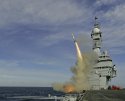Recent photos reveal the construction of China’s largest amphibious assault ship is progressing at a shipyard in the metropolis of Shanghai, as the country strives to plug gaps in its military’s amphibious capabilities.
One photo, taken from a boat sailing on the Huangpu River, which runs through Shanghai, eastern China, shows the main bridge structure has recently been joined to the hull of the first Type 075 amphibious assault ship.
Other photos taken from surrounding buildings and within China State Shipbuilding Corporation’s Hudong-Zhonghua shipyard have also been posted online, with one taken from the rear showing the configuration of the stern elevator and part of the well dock.
The Type 075 is roughly analogous to the U.S. Navy’s Wasp-class landing helicopter dock. The Chinese ship will feature a large flight deck capable of handling five to six large transport helicopters taking off and preparing for flight simultaneously. It will also have parking and hangar space for more helos.
Its well dock is expected to be able to accommodate multiple conventionally powered and/or air-cushioned Type 726 landing craft.
Given the pace of construction, the ship is expected to launch this year. The shipyard at Hudong-Zhonghua is also responsible for building the 25,000-ton Type 071, or Yuzhao landing platform dock, which is the currently the most capable amphibious ship in service with the People’s Liberation Army Navy. Six of these ships are active, and two more are undergoing final work at the shipyard.
It’s unknown how many Type 075s China plans to eventually operate, although some reports suggested at least three such ships will be built.
Once in service with the People’s Liberation Army Navy, or PLAN, the Type 075 — which is expected to displace between 35,000 and 40,000 tons — will represent a significant boost to the service’s amphibious capabilities. The PLAN is mostly outfitted with smaller, less capable landing ships alongside the Type 071s.
The U.S. Defense Department’s 2019 China Military Power Report suggests the PLAN has a near-term focus on building up an amphibious force geared toward smaller-scale expeditionary missions as opposed to the capability necessary for a large-scale, direct beach assault, i.e., a full-scale Taiwan invasion. The report suggests this effort would require a significant expansion of China’s landing ship force.
China has also reorganized the PLAN Marine Corps, with plans for the force to grow from two brigades with 10,000 troops to seven with more than 30,000 personnel, according to the report.. The force’s mission is also to expand to “include expeditionary operations beyond China’s borders” by 2020 as part of planned reforms to China’s military, the report says.
However, many of the six marine brigades now in existence are not fully prepared for operations. The new brigades were formerly coastal defense or infantry units, and have been re-designated as Marine Corps units, although the process of reequipping and retraining them is ongoing. The Pentagon report concludes that “China lacks a sufficient inventory of wheeled armored vehicles” to adequately support “multiple expeditionary deployments.”

